What can AI do for HR?
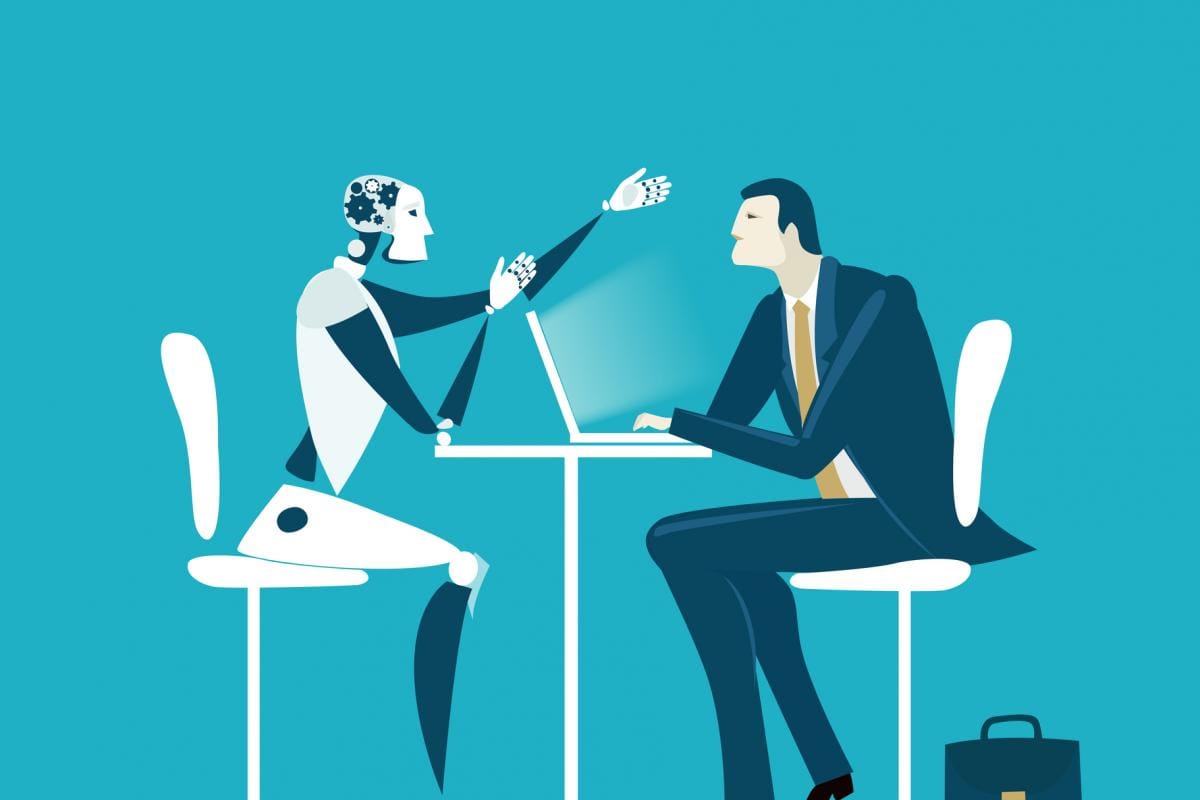
The heart of any organization is its human resources. From hiring to developing employees to evaluating their performance, human resources (HR) plays a crucial role in the continuous development of a company. On the surface, it may seem like a simple task. However, it’s actually one of the most complex and challenging jobs in the world. Since it’s mostly about dealing with people, it requires a wide range of experience and expertise. To do it well, stress management and excellent communication skills are essential.
When you talk to people in human resources, you’ll find that most of them are very interested in the efficiency gains that AI can bring to their work. They are also curious about how AI will change organizational structures and the role of HR within them. However, at the same time, many believe that HR is a human-to-human process that is difficult to automate and challenging to replace with AI. After talking to various HR professionals, and developing and testing AI agents, I have concluded that the process of HR management can be improved and made more efficient with AI. Improving the work of the human resources department means enhancing the operation and management of the company’s organization, which in turn leads to efficiency gains across the company.
In this article, I’ll provide examples of how AI can be used in human resources and show how humans and AI can work together. All of the examples below are based on dummy data to illustrate the logic of applications across the business, and any references to specific individuals or companies are purely fictional. All demonstrations were created using Kompas AI (https://kompas.ai)
1. Create a job posting (Job Description)
A job posting is an important first impression between an organization and a potential employee. A well-written job description clearly communicates the key tasks, responsibilities, required skills, and experience of the job, making it easy for candidates to determine if they are a good fit for the position. However, inaccurate or vague job descriptions can be confusing to candidates and may lead them to apply without a clear understanding of the job. While properly presented qualifications can help attract the right talent, a poorly written job posting that includes unnecessary requirements can discourage the right candidates from applying and reduce the efficiency of your hiring process.
Therefore, job postings should be carefully crafted. However, if your HR staff doesn’t have a good understanding of the job or lacks the necessary information, the job posting may be unclear or inadequately written. Getting the job description right can also be a challenge when the person in charge of hiring is inexperienced or when a company is expanding into a new area of business and needs to hire talent for unfamiliar roles.
In these situations, AI can be leveraged to quickly generate a basic job description (JD) and revise it based on feedback from the hiring manager, saving time while creating a more organized and cohesive job description.
Below is an example of a job posting for a Senior Marketer position for Kompas AI.
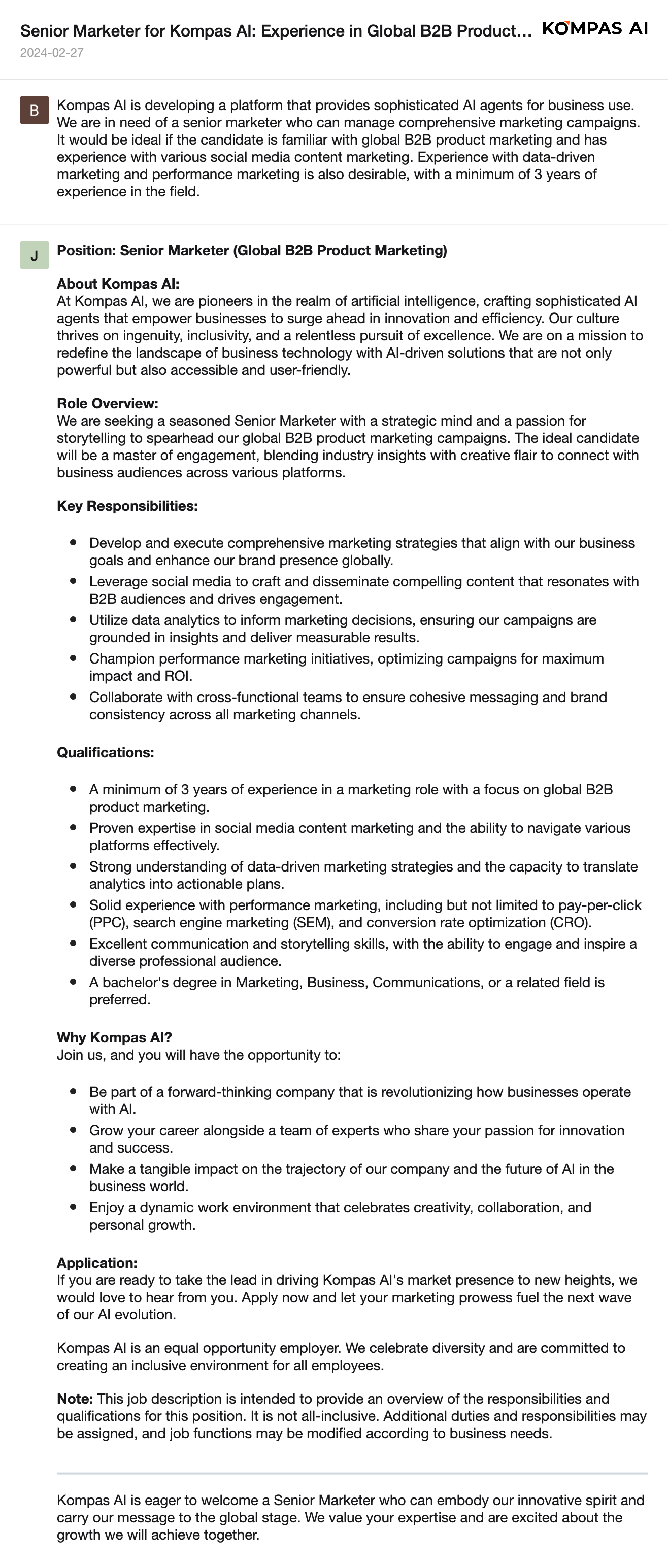
The input is simple in this example; providing more detailed information can yield better results. In this way, AI can be used to quickly create a basic framework, which can then be built upon to craft a more detailed and sophisticated job description.
2. Resume screening
If you’ve written a compelling job posting, you’re likely to receive a lot of resumes from relevant candidates. If the job is very specialized or unattractive, the number of resumes received will be small, and you will have enough time to spend on each one. However, if the job is generic or attractive, you will receive a large number of resumes.
The purpose of resume screening is to quickly evaluate candidates based on their qualifications, experience, skills, etc., and select the most qualified ones for the interview stage. During this process, human resources personnel review candidates’ resumes to determine their fit with the job. It’s difficult to efficiently evaluate a large number of applicants; the right candidates can be overlooked, and the conscious or unconscious biases of screeners can lead to the rejection of qualified candidates or the selection of unsuitable ones.
This is where AI can be used to automate the screening process. By uploading resumes and inputting job descriptions, AI can assist in evaluating candidates more objectively. Unlike traditional automated resume screening tools that are limited to searching for keywords and terms, AI can take into account a deep understanding of the job requirements and the overall context of the resume to produce more efficient and valid results.
Below is a screen capture of the screening process. Based on the job description, the AI creates evaluation criteria, reviews each candidate’s resume according to these criteria, and presents the results.
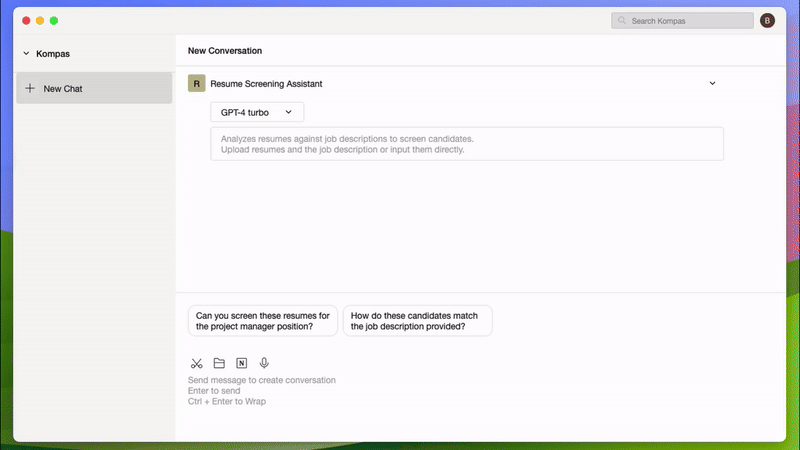
3. Prepare for interviews
Once you’re done screening resumes, you need to set up a suitable interview for the candidate. Interviews are an important step in assessing a candidate’s skills and experience, as well as their fit with your company culture. Providing a positive interview experience can help your company build a good image and improve brand recognition.
Effective interviews require thorough preparation, structured questions, and clear evaluation criteria. However, if human resources personnel are interviewing candidates for various positions and do not have a good understanding of the job, they may not be able to ask appropriate and valid questions. Additionally, if they lack interviewing experience, the interview process can leave a negative impression on the candidate. An unprepared interviewer may miss important questions or fail to properly assess a candidate’s competencies, while conscious or unconscious biases can skew the interview process and lead to missing out on promising candidates.
To prevent this, HR departments work to train interviewers and set relevant standards. While AI can’t take over the whole interviewing process, it can aid interviewers in their preparation. The AI can generate a set of questions based on the job description and the candidate’s resume, which can be used as the foundation for a more meaningful interview. With a ready-made set of interview questions, interviewers can prepare for more in-depth discussions and convey to the candidate that they are well-prepared.
In the example, I entered the job description for a senior marketer and the resume of the candidate. AI was able to reference the details of the resume to create interview questions that are tailored to the candidate.
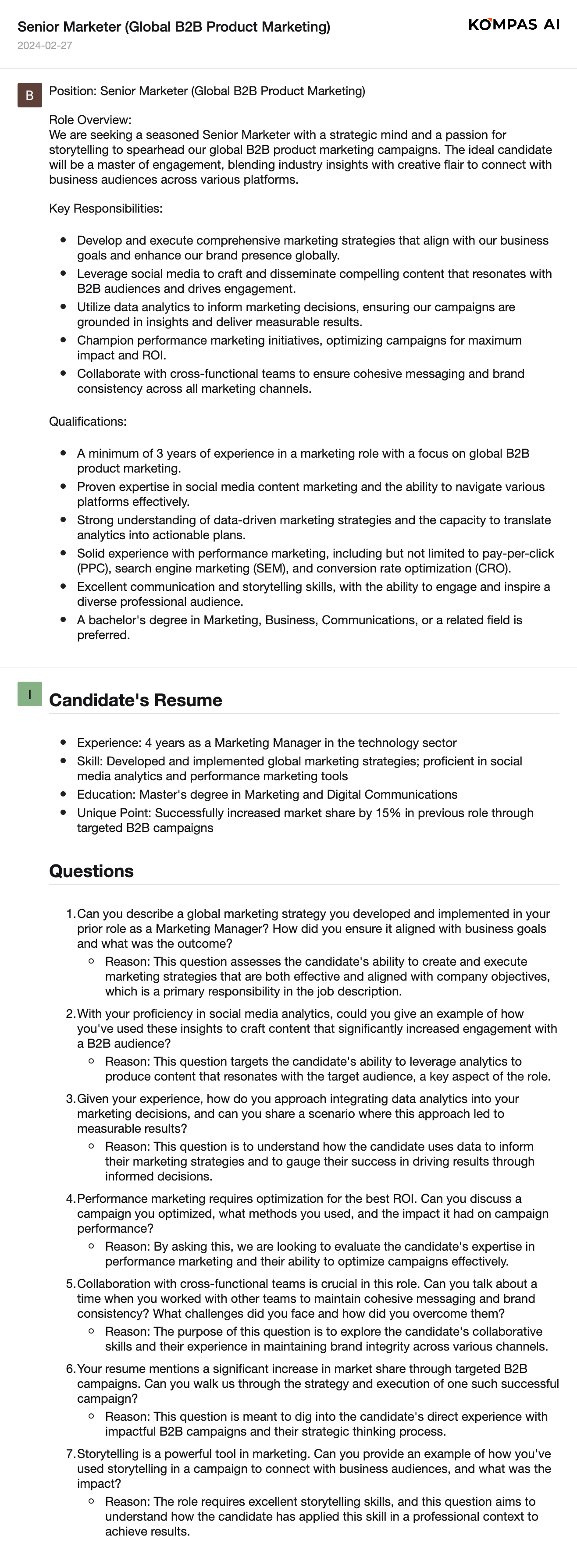
4. Set up candidate evaluation criteria
In order for the hiring process to be effective, it’s important to set clear evaluation criteria early on. Having clear evaluation criteria minimizes personal bias and subjective judgment, ensuring that all candidates are evaluated consistently and fairly. The clarity of criteria facilitates better communication between interviewers and between line management and human resources, allowing for more refinement of future job postings and resume screening processes. Accurate evaluation criteria also help provide specific and useful feedback to candidates, which not only contributes to their improvement but also leaves a positive impression of the company.
For this reason, establishing clear hiring criteria and candidate evaluation metrics at the onset of the hiring process is essential. Once we have a job description and required qualifications, AI can assist in clarifying what needs to be evaluated during the hiring process. Based on the evaluation criteria suggested by the AI, we can quickly and easily finalize the scorecard by identifying what is missing or what needs to be re-ranked in terms of importance. Similarly, you can also create probationary evaluation criteria for new hires.
In the example below, AI outlined a set of criteria for evaluating candidates during the hiring process based on the Senior Marketer job description mentioned earlier. Using this as a foundation, you can modify and enhance the criteria by applying your own judgment and understanding of the role.

5. Set OKR/KPIs
One of the most important tasks in human resources management is company-wide performance management, where OKRs (Objectives and Key Results) and KPIs (Key Performance Indicators) are the most commonly used methods. OKRs and KPIs clarify the organization’s goals and provide specific directions to move toward them. They help teams and individuals focus on the key areas they need to improve.
Setting OKRs and KPIs can be more complex and challenging than it might seem due to the complexity of the business environment and the varying needs of different stakeholders. Properly setting and managing OKRs and KPIs requires time, people, and financial resources. When these resources are limited, effective execution can be difficult and even overwhelming for business leaders. Employees who are unfamiliar with OKRs/KPIs may misunderstand them or struggle to create appropriate metrics, leading to HR spending significant resources on training and administration.
When setting or reviewing OKRs/KPIs, AI can assist in this process. Based on the results, more detailed and accurate metrics can be set. In principle, OKRs should be written by each employee, setting their own goals. However, by using AI to create a first draft and then revising it based on guidelines, useful OKRs can be developed much faster.
In the example below, a set of company-wide OKRs would be presented, and then OKRs for the marketing team would be derived based on them. Next, the OKRs for each of the three members of the marketing team would be broken down, ensuring alignment with the broader objectives while tailoring them to individual roles and responsibilities.

6. Performance Review (Performance Evaluation)
Performance reviews, or performance evaluations, are an essential part of organizational management. These reviews help employees develop and grow professionally by identifying their strengths and areas for improvement. With continuous feedback, employees gain a clear understanding of their performance and are motivated to achieve their goals. Recognition is a powerful motivator for employees.
However, preparing for performance reviews requires careful consideration. These evaluations must consider various metrics, goal achievement, personal characteristics, and input from other team members. If managers lack sufficient time for preparation, relevant experience, or fail to provide specific and constructive feedback during the evaluation process, it can have negative consequences. Additionally, delivering feedback, particularly negative feedback, can be stressful for managers.
To conduct effective performance reviews, HR and department heads should collaborate to ensure enough time is allocated for the evaluations and that communication methods are well-coordinated. However, this process can be highly individualized and demand significant resources.
This is where AI comes in to help us create an effective and valid feedback structure based on the information gathered. It’s important to remember that AI-provided guidelines are just a starting point. Department heads and leaders can use these guidelines, supplemented by their own experience and communication skills, to deliver more impactful feedback. AI-generated guidelines can help remove some of the guesswork from the process and make communication more efficient, particularly for new leaders who are still developing their review techniques.

7. Design a training program (Staff Training)
Regular training for company members is crucial in fostering a culture of learning and development. When employees perceive that the company is invested in their growth, they tend to be more satisfied with their jobs and show greater loyalty to the organization. Employee training enhances efficiency and effectiveness, leading to improved productivity across the company. Furthermore, it can provide a compelling reason for employees to remain with the company long-term and help decrease turnover rates.
Nonetheless, developing suitable and effective training materials and programs tailored to an organization’s specific needs can be challenging. Training initiatives require time and financial investment to prepare and implement. While outsourcing to third-party specialists is an option, it can be costly and may not yield a program that aligns closely with the organization’s unique culture and objectives.
AI can help solve the challenges of preparing and delivering training programs. With the help of AI, HR departments can craft bespoke training programs and collaborate with department leaders to facilitate their delivery.
In the example below, I asked how to design a training program for new hires on time management and work prioritization. The AI provides suggestions for training content, methods, materials, and more. You can then refine and customize the training program to suit real-world training contexts, enhancing its relevance and effectiveness for the participants.
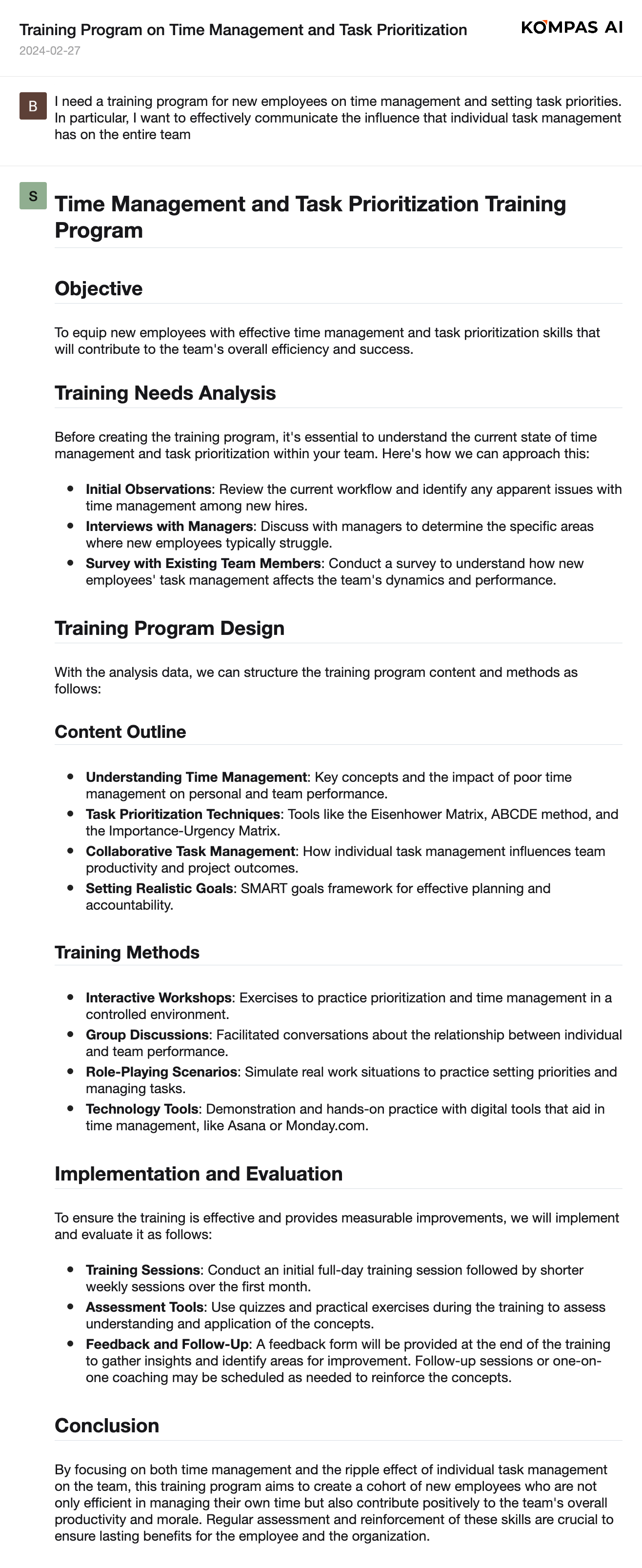
8. Human Resources Strategy
HR strategy is a long-term plan designed to effectively manage and optimize human resources with the aim of achieving an organization’s business goals. It encompasses strategies for finding, hiring, and retaining the right talent over the long term. An HR strategy should be tailored to an organization’s specific context and revisited and adjusted periodically as market conditions change and the organization evolves
AI can help you quickly review your HR strategy to ensure that it is meeting your current business goals, identify gaps, and make improvements. This can significantly reduce the time and cost of strategy construction and review, allowing organizations to revisit and improve their strategies more frequently.
Below is AI’s analysis and suggestions for workforce redeployment and attrition plans as the company realigns its operations.

All the examples presented above were created using Kompas AI (https://kompas.ai ). The AI agents mentioned are available directly through Kompas AI. Implementing similar functionality with ChatGPT is possible in a simpler manner, but it may not be easy to achieve the same level of results as the examples
The applications mentioned above are the result of leveraging AI not just as a knowledge tool, but as a reasoning engine based on a variety of information. Through this process, AI can assist people in making better decisions. While AI cannot completely replace human work, it can facilitate the completion of routine tasks more quickly and effectively. This enables us to devote more time and energy to more important matters and makes it easier to undertake tasks that were once out of reach.
Finally, let’s take a look at what you need to keep in mind when applying AI to human resources
1) Avoid entering sensitive work data into services like ChatGPT, Gemini, or Claude.
- Services like ChatGPT, Gemini (BARD), and Claude, which are easily accessible on the web, clearly state that the data you enter can be used for training their AI models. Therefore, it is crucial not to share sensitive personal information (such as resumes), organizational goals, performance reviews, etc. This precaution is vital not only for HR but for everyone in the company when integrating AI into their work.
- Alternatives include building your own large language model (LLM) infrastructure or using an AI solution developed for the workplace, like Kompas AI. These solutions are specifically designed to ensure that your data is not utilized to train AI models and can safely process sensitive materials.
2) Don’t blindly trust AI
- While AI can offer fresh insights or uncover knowledge we might not have considered, we must not treat the information provided by large language models (LLMs) as infallible or exhaustive. Particularly in cases where they are not finely calibrated, LLMs can produce “hallucinations” or generate misleading information. Therefore, it’s crucial to use AI with a discerning mindset, critically evaluating its output. Remember, AI is just a tool, and humans are the ones who make the final decisions.
Once we realize that AI can be of great help in the most “human” of fields, such as human resources, the potential for its application in other areas seems boundless. To learn more about AI’s impact on different professions and why its presence may not yet be widely felt, check out this article (How will AI change our jobs?).
In future articles, I will explore how AI can be utilized across various professions and share real-world examples. All demonstrations will be created using Kompas AI. Currently, Kompas AI offers over 70 sophisticated AI agents that are ready for immediate integration into diverse professional roles. I invite all of you to experience Kompas AI firsthand and discover how AI can enhance their work.

